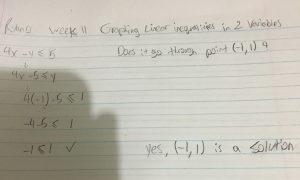This week I learned how to find different angles in standard position. First if they give you the point, then you have to determine the side lengths of the triangle. Then you use pythagoreas theorm to determine the hypotenuse. After that, then you use SOH CAH TOA to find the angle.
Category Archives: Math 11
Week 15 – Adding and Subtracting Rational Expressions
Week 14 – Multiplying Rational Expressions
Week 13 – Solving Absolute Value Equations
This week I learned how to solve absolute value equations. This question asked to use algebra to solve so I have to find the roots of the equation. Usually you would need to do one positive equation and one negative, but for this case the positive gave me both roots. All I had to do was move the 2 over to the other side of the equation, then factor it out. That gave me both of my roots. The negative one didn’t work for this equation as well.

Week 10 – Solving Quadratics by Factoring
 This week I went back and looked at solving quadratics. First step is to look at the “a value” if it’s just x2
This week I went back and looked at solving quadratics. First step is to look at the “a value” if it’s just x2
then it’s a lot easier to work with. Next step is to find the factors of the “c value” and so it and the “a value” can add to the “b value.” last step is to make it a zero pair by putting the opposite sign to cancel it out.
Week 12 – Solving Systems of Equations Algebraically
Week 11 – Graphing Inequalities and Systems of Equations
This week I learned how to determine weather a point is going to be a solution in a inequality.
First you have to move either x or y over, in this case the y was easier to move because it was originally negative. After you move your x or y over, then you plug in the point that you have to find out if it’s a solution or not. If you plug everything in and solve, it’ll be a solution if the inequality is true.
Week 9 – Analyzing Standard Form
This week I learned how to use standard form, from standard form you can find the vertex, and to find the y intercept, you just plug in 0 where x is and solve for the rest of it. If you find where the parabola opens and where the vertex is, you can tell how many x intercepts there will be, in this question the parabola opens up and the vertex has both positive numbers so there were no x intercepts.
Week 7 – Interpreting The Discriminant
This week I learned how to find the discriminant. To find the discriminant, you take the b2 – 4ac
from the original quadratic formula, the discriminant is how you can find out how many roots the quadratic equation is going to have. If the discriminant above 0 it will have 2 roots, if the discriminant is 0, you will have 1 root, and if the discriminant is negative, there are no roots.







